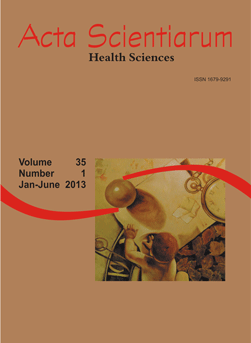<b>Effects of swimming on the testicular histomorphology of alcoholized rats</b> - doi: 10.4025/actascihealthsci.v35i1.10794
Abstract
The objective of this study was to examine whether the practice of long-duration, low-intensity physical exercise helped reverse changes observed in the testes of rats subjected to alcohol dependence induced by semi-voluntary intake. Forty male rats were distributed into four groups: alcohol no exercise (ANE); alcohol with exercise (AWE); no alcohol no exercise (NANE); no alcohol with exercise (NAWE). The cachaça ("51" brand) was offered in the following dilutions: 10% (10 days), 15% (11 days), 20% (12 days), 25% (12 days), 30% from the 45th to 120th day, when the alcohol was replaced by drinking water. On the 120th day, the groups NAWE and AWE were assigned to swim in individual tanks with water temperature around 30ºC for 20 minutes, 5 days week-1 for 8 weeks. In the ANE group there was a depletion of the seminiferous epithelium, while in AWE rats the majority of seminiferous tubules were unaltered. Compared to the AWE group, there were reductions in tubular diameter and the height of the seminiferous epithelium in the ANE group. The results showed lesser testicular atrophy in animals that exercised than in sedentary ones. Physical exercise after the discontinuation of alcohol seems to accelerate the process of recovery of damaged tissue.
Downloads
Download data is not yet available.
Published
2012-10-31
How to Cite
Mesquita, S. de F. P., Barbieri, M. F., Fernandes, E. V., Andrade, F. G., & Arrebola, N. R. (2012). <b>Effects of swimming on the testicular histomorphology of alcoholized rats</b> - doi: 10.4025/actascihealthsci.v35i1.10794. Acta Scientiarum. Health Sciences, 35(1), 37-42. https://doi.org/10.4025/actascihealthsci.v35i1.10794
Issue
Section
Physical Education
DECLARATION OF ORIGINALITY AND COPYRIGHTS
I Declare that current article is original and has not been submitted for publication, in part or in whole, to any other national or international journal.
The copyrights belong exclusively to the authors. Published content is licensed under Creative Commons Attribution 4.0 (CC BY 4.0) guidelines, which allows sharing (copy and distribution of the material in any medium or format) and adaptation (remix, transform, and build upon the material) for any purpose, even commercially, under the terms of attribution.
Read this link for further information on how to use CC BY 4.0 properly.























5.png)







